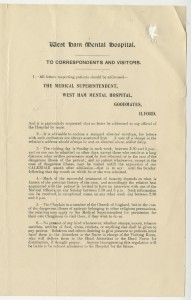Today, we have a guest post written by one of our project volunteers, Leonora Fane-Saunders.
***
It is sadly apparent that mental health was not well understood in the late 19th and early 20th centuries. The prevailing view at the time was one of institutionalisation, and many people with learning disabilities or mental health conditions found themselves sent to asylums and other similar institutions, to live apart from the rest of society. These institutions may have been seen as places of treatment, where people could be given specialised care, but they were also places of segregation.
The records from the Children’s Society [then the Waifs and Strays’ Society] show some of the attitudes and language prevalent at the time. An example of this is a letter recommending that a child be sent to an asylum in 1917. (Click to enlarge.)
Dear Mrs De Gruchy
I am of opinion that
the little girl Gertie [surname]
from St. Cadocs Home Caerleon
whom I saw today is of
defective intellect – and not
likely to profit from the
training given at St. Cadoc’s
Home.
From the statement
of the Matron of the Home it
appears that the child has a
very deficient moral
sense in the matter of
truthfulness & honesty
and I think her example may
have an evil influence on the
other children in the Home.
Both on this account and
on her own I think she would
be much better placed in
an institution for mentally
deficient children where
the training and discipline
would be more suitable to
her case.
Yours Sincerely
Wm. F. Nelis MD
Med Supt. [Medical Superintendent]
In this letter there is nothing that today would today be considered grounds for institutionalisation and the terms used in this letter would now be considered highly inappropriate. It is possible that the child suffered from a learning disability that in turn led to the poor behaviour in the home.
The asylums had very strict rules that seem akin to those found in a prison. A list of rules governing visitors to inmates at the West Ham Mental Hospital (see above, click to enlarge) show that visiting hours were restricted to two and a half hours per week unless under special circumstances in which case written permission was required. Presents could also only be given to inmates through the Attendant or Nurse in charge of the visiting room. Of the twenty four children who were admitted to an asylum or other such mental health institution from The Society’s care between 1894 and 1920 only two are known to have left the asylum. It is interesting to note that the two that left were different in that they were sent to the asylum for what appears to have been stress cause by over work whilst in service. The others were sent to the asylum for difficulties in learning what the children were being taught in the homes and for poor behaviour.
Although now, with the benefit of hindsight, it is easy to look back with horror at these institutions, it is also easy to forget that the first asylums were set up with humanitarian intentions as places that could care for the mentally ill and potentially cure them. Before then such people were usually hidden away under the care of their relatives. Good intentions were lost amidst the increasing asylum population, inadequate staff, lack of understanding of mental health and the fact that any man and his dog could set up a private asylum. Those who started the first asylum probably looked back in horror at the way the mentally ill were treated one hundred years before, and who’s to say people one hundred years from now might not do the same.
Most asylums were shut down in the late 20th Century and our knowledge and understanding in identifying and treating mental health issues has increased since then. While it can be upsetting to us now to see how people used to be treated 100 years ago, records such as those highlighted here are important. It is through understanding and discussing the past that we can begin to learn from previous mistakes and pave the way for a better future.
Want to find out more?
A previous blog post discussing historical attitudes to disability can be found here:
http://www.hiddenlives.org.uk/blog/2012/05/the-changing-perceptions-of-disability
A brief history of West Ham Mental Hospital can be found here: http://ezitis.myzen.co.uk/goodmayes.html
See the Museum of Disability, the Science Museum and this post from the National Archives for more information about the history of attitudes towards learning disabilities and mental health conditions.


